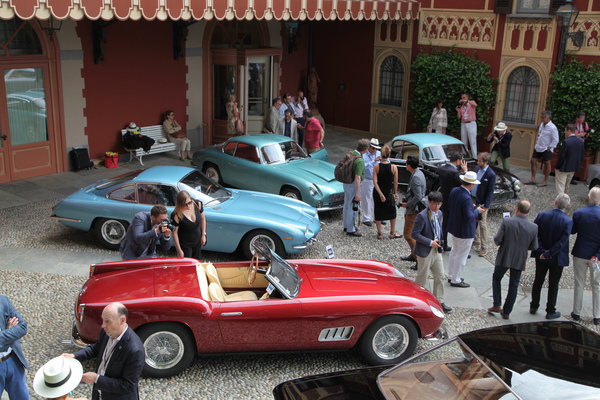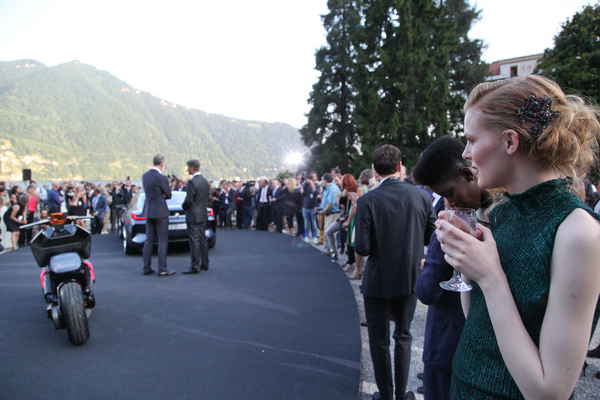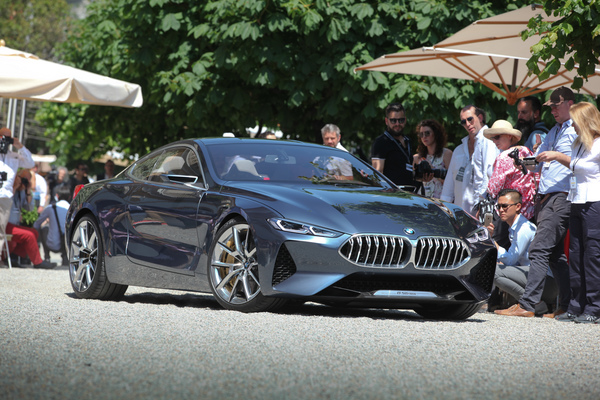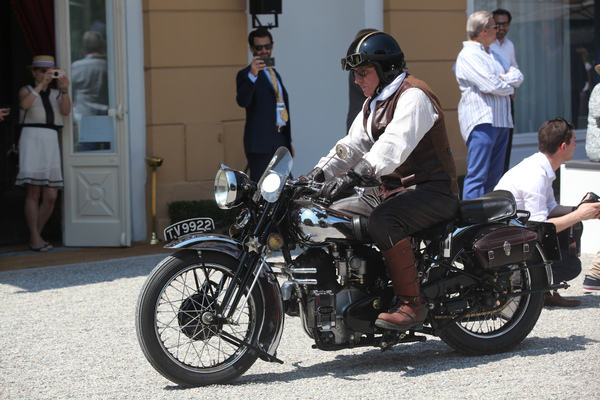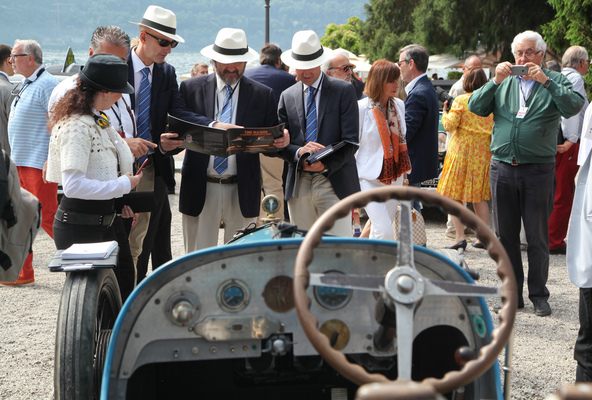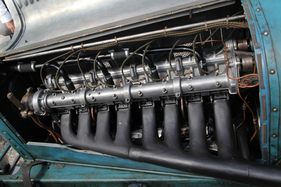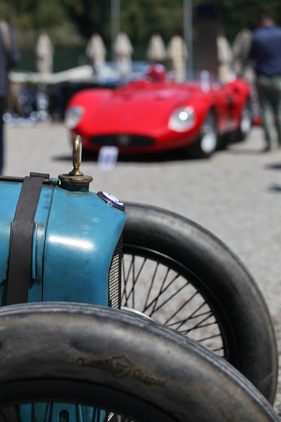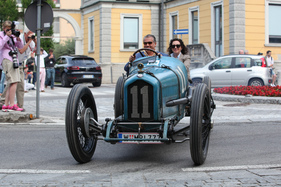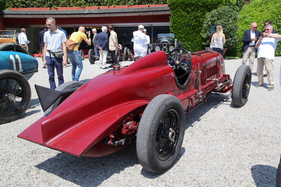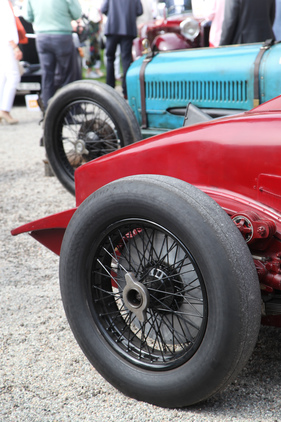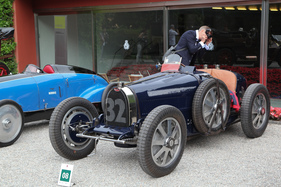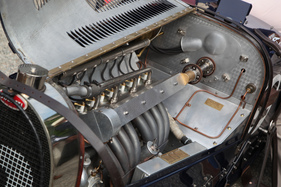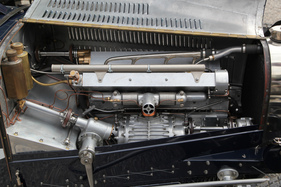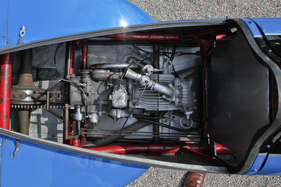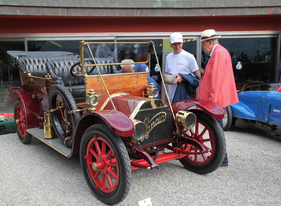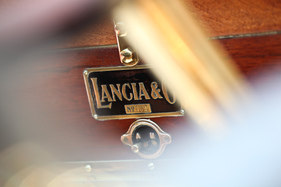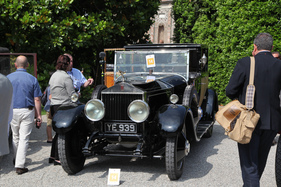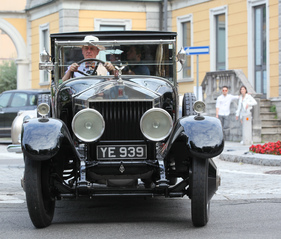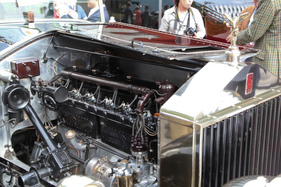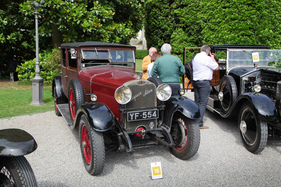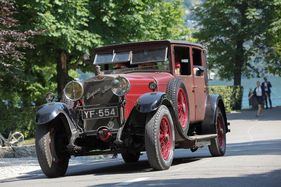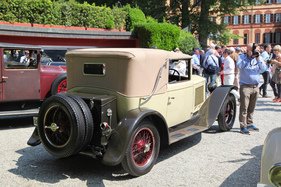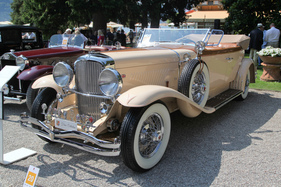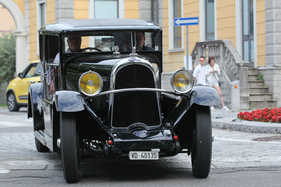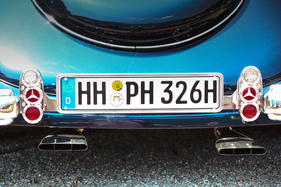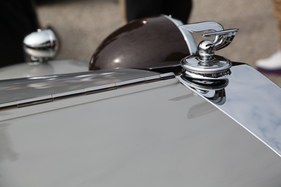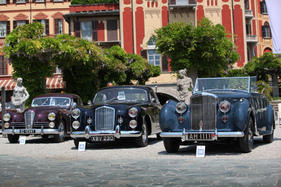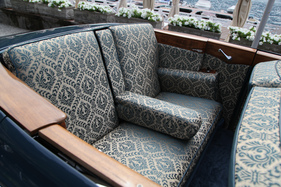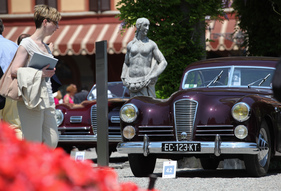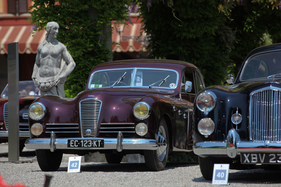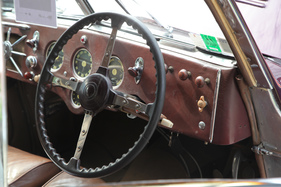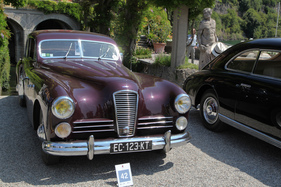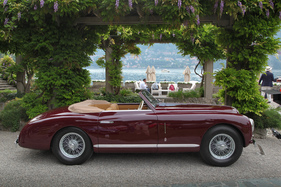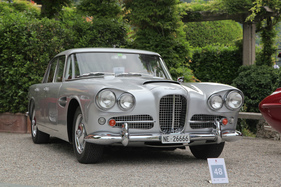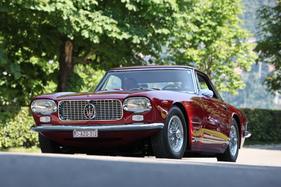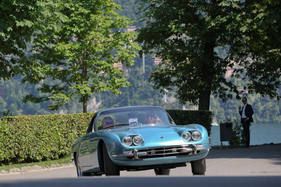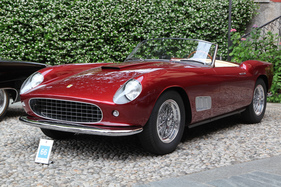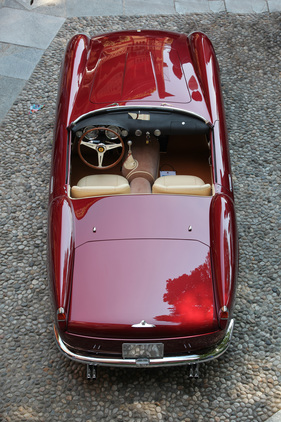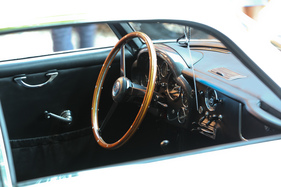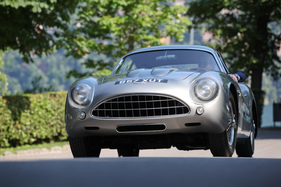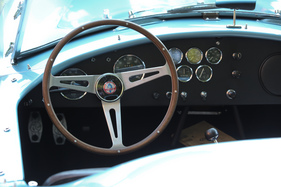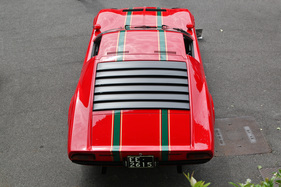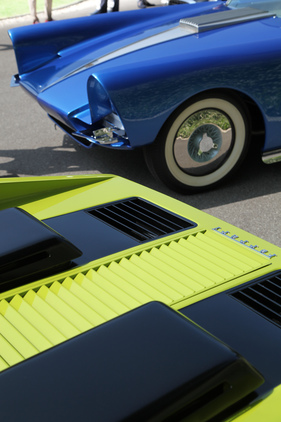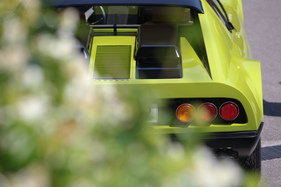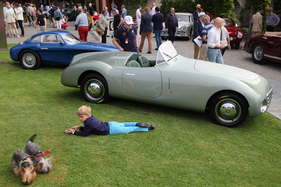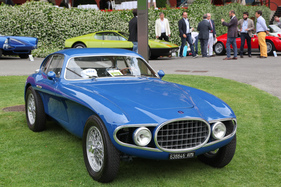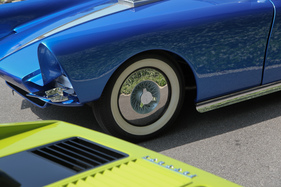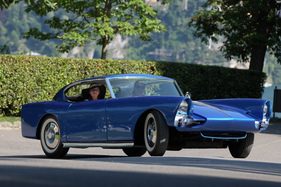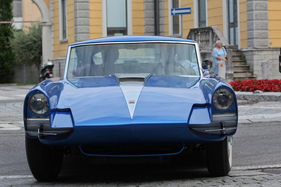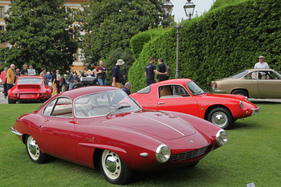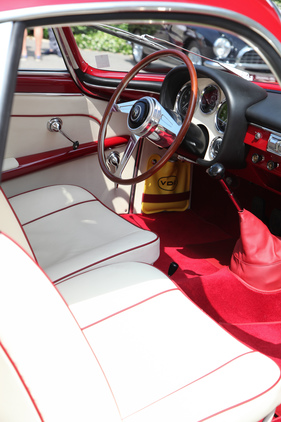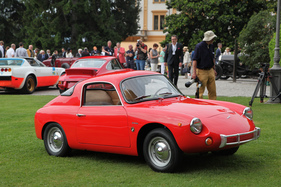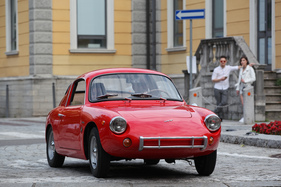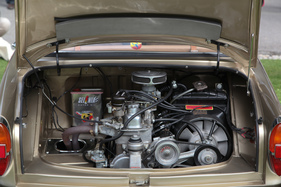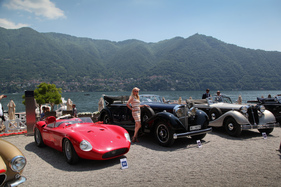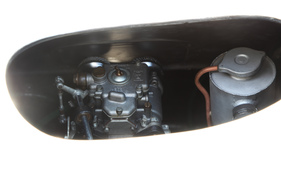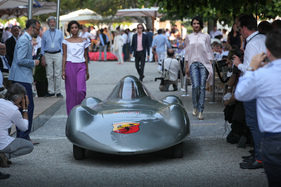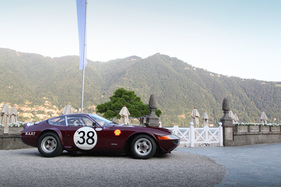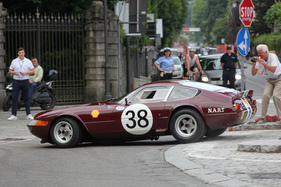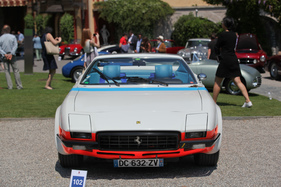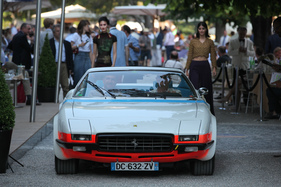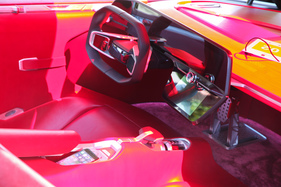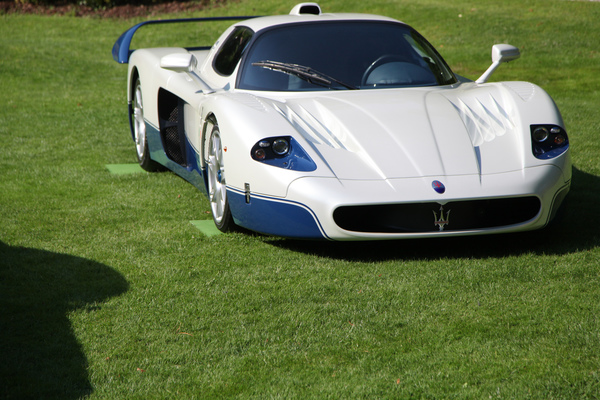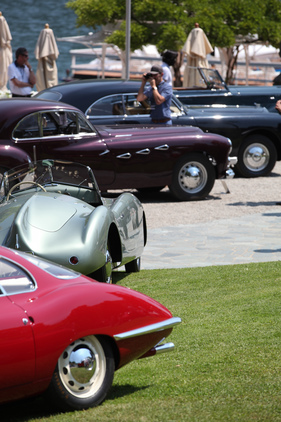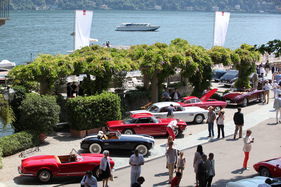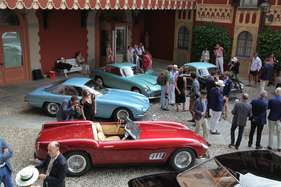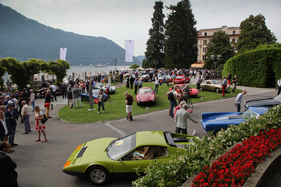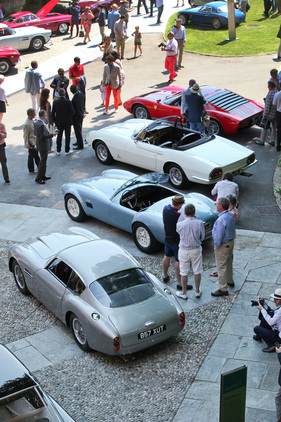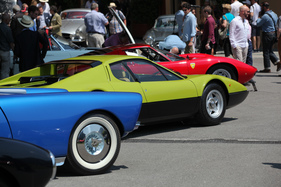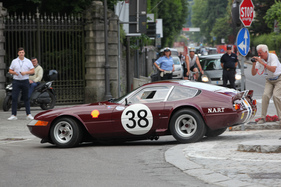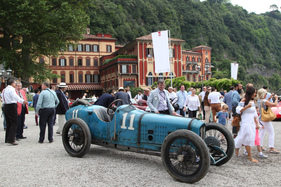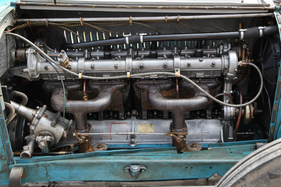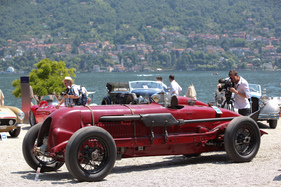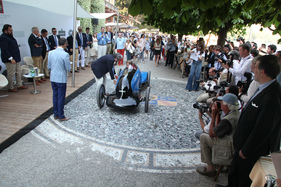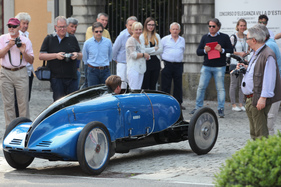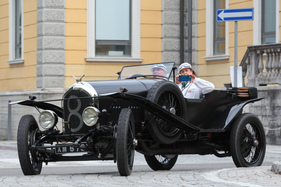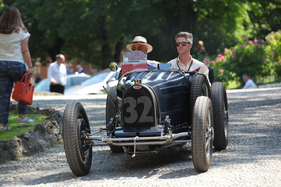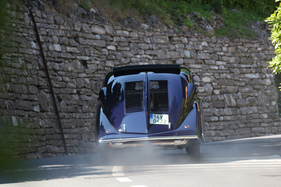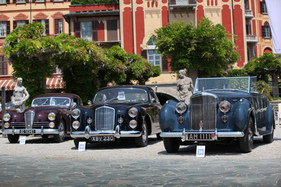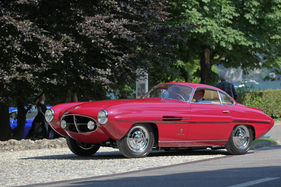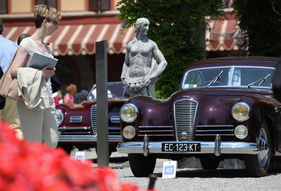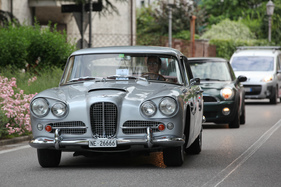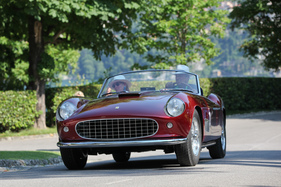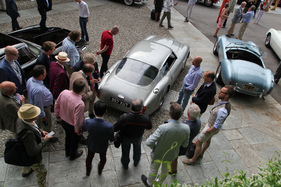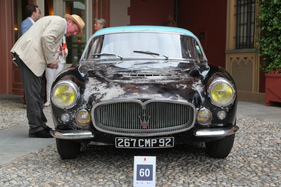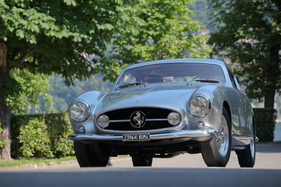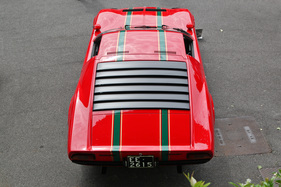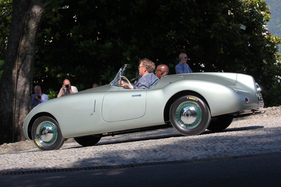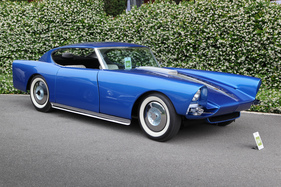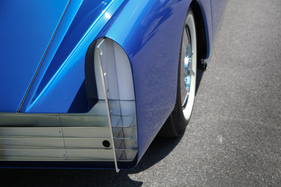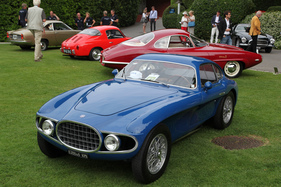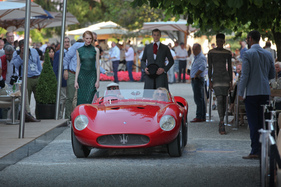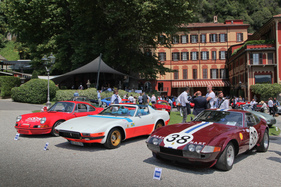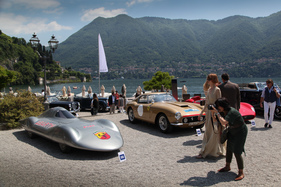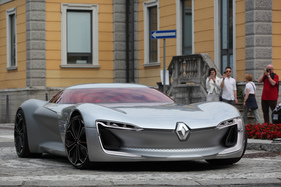The Concorso d'Eleganza Villa d'Este, held in the village of Cernobbio near the northern Italian city of Como, is one of the most prominent beauty contests for cars (and motorcycles) in the world. A car that wins the coveted "Best of Show" trophy usually increases significantly in value. Participants travel from all over the world to present their cars, with almost 1/3 of all vehicles coming from overseas in 2017.
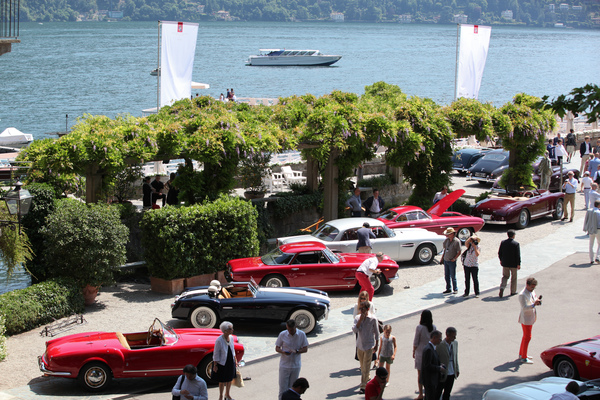
Traditionally, the Concorso begins on Saturday with the non-public viewing of the vehicles in the park of Villa d'Este. This presentation is concluded by a promenade past the members of the jury. At the end of this ceremony, the Coppa d'Oro will be awarded, with the invited public voting for what they consider to be the most beautiful and charming car.
On Sunday, the cars are then displayed in the nearby park of Villa Erba, with hundreds of spectators attending the parade early in the morning and taking photos with their cell phones and cameras as much as their digital electronics can handle. From 09:30, the vehicles can be admired by anyone who is prepared to pay the required entrance fee. In the afternoon, the class rankings and the overall winner (Best of Show) will be announced.
Best weather conditions
In recent years, it has always been at least partly damp, but on May 27 and 28, 2017, the weather showed its best early summer side. It even got really warm, so that some owners of vehicles that were not quite temperature-stable were worried about whether their cars would survive the slow lap around the Hotel Villa d'Este.
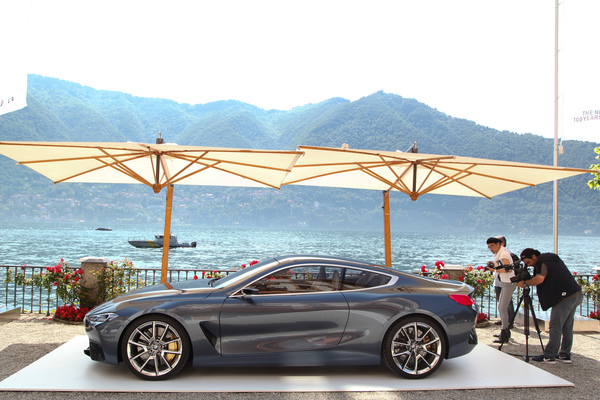
The organizers simplified the procedure by only allowing most of the cars to drive half a lap. Then the cars disappeared back into the underground garage. Not all of them managed the half lap; the Maserati A6G/2000 Gran Sport with Frua bodywork from 1956, which was auctioned off two years ago for a lot of money as part of the Baillon collection, stopped shortly after passing by.
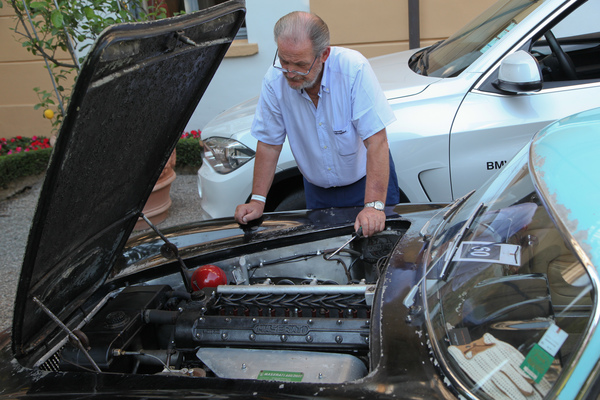
But help was at hand, Valentino Balboni, the well-known former Lamborghini test driver, grabbed a screwdriver and finally the car ran again for the next few meters.
Long-distance beauties
The 51 old vehicles (unfortunately 1 car was unable to compete) were divided into eight classes, within which class wins and honorary mentions were awarded. The "Speed Demons - Endurance Pioneers of the Golden Age" class kicked things off and included an impressive range of former racing and record-breaking vehicles.
The class winner, a Ballot 3/8 LC from 1920, could already be viewed at the Retromobile in February 2017. At that time, however, the elaborate engine - eight cylinders in a row, four valves per cylinder, two overhead camshafts - was not yet functional. The Austrian owner has since been able to make the drive work.
According to him, the assembled engine is the only one of its kind that runs. The car competed in the Italian Grand Prix, Indianapolis and Paris/Le Mans, among others, and later at Brooklands, where Malcolm Campbell drove it.
Hardly less exciting was the 1929 Birkin Bentley 4 1/2 Litre with its powerful supercharger. As a genuine racing car, this car had neither an electric starter nor a cooling fan. Starting it alone required a great deal of sensitivity and a few strong men to push it.
Tim Birkin drove the car to a lap average of 222.03 km/h at Brooklands, consuming 100 liters per 100 kilometers. It can be assumed that even then, not all of the fuel ended up in the carburetor. The Bentley did not win a prize in Cernobbio, but it was certainly impressive.
The Lurani Nibbio from 1935, a record-breaking vehicle that ran at an incredible 160.9 km/h with a 0.5-liter two-cylinder engine from Moto Guzzi, won prizes instead. The two-cylinder engine was later replaced by a 250 cc single-cylinder engine with a supercharger and further records were set.
Behind the soapbox-like car with free-standing wheels and aerodynamic bodywork from Riva was Count Lurani, whose nephew presented the car at the Concorso so sympathetically that it immediately won the "Coppa d'Oro" audience award and received a Mention of Honor from the jury.
However, the Bentley 3 Litre from 1922, which was the first Bentley to compete in the inaugural 24 Hours of Le Mans and set the fastest lap, also deserved prizes. It achieved fourth place overall and provided the impetus for the British manufacturer's many years of successful racing activity.
And then there was the Bugatti Type 51 from 1931, which Richard T. Collier bought back in 1960. The Type 51 was an improved version of the famous Type 35, which now produced 180 hp from the two-liter eight-cylinder engine thanks to overhead camshafts and three valves with a supercharger. The car on display was successful in several Grand Prix races and was also an (elegant) eye-catcher.
Style and elegance in the classic sense
The two classes "Travelling in Style - around the world in 40 Years" and "Goodbye Jazz - full speed into the 1930s" impressed with pre-war vehicles of classic elegance and design, i.e. cars that you would generally expect to see at a beauty contest.
Corrado Lopresto drove up in the oldest surviving Lancia, a 12 HP Tipo 51 "Alfa" from 1908, while the Rolls-Royce Phantom I from 1926 was also impressive as Charles Clark's Brogham de Ville, equipped with the amenities of a saloon.
However, the jury gave preference to the 1930 Duesenberg Model J Convertible Berline by Murphy, while the elegant 1932 Lancia Dilambda with Viotti Torpedo bodywork received an honorable mention.
Among the cars from the 1930s in Class C, the beautiful Alfa Romeo 6C 1750 Gran Turismo by Castagna from 1932 came out on top, impressing not only the jury but also the young public voters. A Tatra 77 from 1934, which also received a prize for the best interior, was deservedly mentioned in honor.
Only it didn't really want to walk, it coughed badly around the hotel.
Design upheavals
A variety of shapes and colors was the order of the day in the class "Faster, Quieter, Smoother - Heroes of the Jet Age" (Class D).
The spectrum ranged from the comparatively convervative Bentley Mk VI as a Drophead Coupé by Mulliner from 1947 and as a Cresta Coupé by Pinin Farina from the following year to the Fiat 8V Supersonic by Ghia, which was created just four years later and must have looked very futuristic at the time.
In comparison, the Maserati 5000 GT Coupé by Allemano from 1962 and the four-door Lagonda Rapide from 1962 looked rather conservative, while the Salmson G-72 coupé by Saoutchik from 1951 was not as opulent as other Saotchik designs.
Incidentally, the vehicle is still in practical use, but the owner wanted to complete the return journey of several hundred kilometers on the road. For the outward journey, however, he had decided to load the vehicle, as he did not want to take the risk of not arriving.
The Swiss owner of the Lagonda Rapide was less squeamish, which earned him the prize for the longest journey on the road. The class winner, however, was the Fiat 8V Supersonic, while the Mulliner-Bentley received an honorable mention.
The investors' favorites
The two classes "The Grand Tour Continues - The next 40 Years" (Class E) and "Fast and Flamboyant - Playboy's Toys" (Class F) were able to show almost everything that classic car investors like to invest their money in today.
For example, there was the prototype of the Ferrari 250 GT Spyder California from 1957, one of the legendary Siata 208 S from 1954, one of the rare Aston Martin DB4 GT Zagato from 1962 or a Lamborghini 350 GT from 1965.
Probably the most controversially discussed car, however, was the Maserati A6G/2000 Gran Sport from 1956, already mentioned at the beginning, bodied by Pietro Frua, which is still in barn-find condition as it was auctioned two years ago.
Is this patina or simply poor maintenance, some observers wondered in view of the weathered paintwork and the clearly visible signs of corrosion. In any case, the car did not win a prize.
A Ferrari 250 Europa GT Speciale from 1955 (Class E), built as a one-off and with a very special radiator emblem, and the Lamborghini Miura P 400 from 1968 (Class F) from Switzerland were voted best in class.
Elegance versus bizarreness
Perhaps the most exciting class in terms of form was the one with the letter G and the title "Supergioiello - Little Toys for Big Boys". Those looking for contrasts in form found their terrain here. Flowing lines could be seen on the Fiat 1100 from 1946, which was dressed by Pietro Frua.
The Astra Coupé from 1952, which the American creator Jay Everett, 25 years old at the time, had built as a one-off with a tubular frame and aluminum body, has almost rugged lines. In order to keep the front low, the radiator was moved to the rear, and functionality was sacrificed in some places for design.
Under the front end, an Oldsmobile eight-cylinder engine provides propulsion. Whether you like the Astra Coupé or not, its design language was certainly extraordinarily progressive when compared with British or Italian products of the time.
However, it was not enough for a prize, as this went to the Alfa Romeo Giulietta SS prototype from 1957, the predecessor from the hand of Franco Scaglione, who worked at Bertone and adopted many details from the BAT showmobiles.
In contrast to the later production version, the prototype did not have a classic Alfa radiator. The Alfa, which is owned by Corrado Lopresto, impressed the jury so much that they also voted it "Best of Show".
The visually attractive Osca MT4 by Vignale from 1952 had to go home without a prize, but the cute Intermeccanica Imp 700 GT from 1961 did not win a trophy either. Actually, every car in this group would have deserved an award, but the "Mention of Honor" went to the Fiat 8V Vignale from 1955.
Racing aesthetics
The vehicles in the "Shaped by Speed - Racing through the Decades" class were more about aerodynamic efficiency than beauty. Nevertheless, the people at Fantuzzi certainly had a lucky hand when they dressed the Maserati 300 S in 1958 The open-top sports car deservedly won the class, because aerodynamics could hardly be more elegant.
The other extreme in this class was certainly the Ferrari 365 GTB/4 Spyder N.A.R.T. from 1972, a racing car developed by Michelotti with an electrically retractable rear window. The car was entered twice for Le Mans, but did not take part in the race in either 1975 or 1978.
The Abarth 1000 Bialbero Record from 1960 with Pininfarina bodywork was much better known and more successful, at least in record-breaking races. In 1960, this car reached an average speed of 191.376 km/h over 10,000 kilometers.
The elegant record-breaking car, which was certainly not the most comfortable to drive, was awarded an honorary mention in Cernobbio as well as the prize for the best-preserved post-war car.
Thin concept car class
The modern concept car class was surprisingly small.
In fact, only two of them even competed, with the trophy for the best show car deservedly going to the Renault TreZor from 2016, an electric coupé with two seats and a fabulously low roofline.
List of vehicles and prizes
The following table shows all vehicles with class allocation, start number and prizes received. The table can be sorted as desired by clicking on the column headings.
| Class | No. | Make | Type | Year | Comment/awards/honors |
|---|---|---|---|---|---|
| A | 02 | Ballot | 3/8 LC | 1920 | Class Winner |
| A | 04 | Bentley | 4 1/2 Litre Single Seater Birkin | 1929 | |
| A | 06 | Bentley | 3 Litre Park Ward | 1922 | |
| A | 08 | Bugatti | T51 | 1931 | |
| A | 10 | Lurani | Nibbio | 1935 | Coppa d'Oro (Audience Award), Mention of Honor |
| B | 12 | Lancia | 12 HP Tipo 51 Alfa | 1908 | |
| B | 14 | Rolls-Royce | Phantom I Broigham de Ville Charles Clark | 1926 | Most elegant Rolls-Royce (Trofeo Rolls-Royce) |
| B | 16 | Hispano-Suiza | T 49 Weymann Sport Saloon Mulliner | 1927 | Best preserved pre-war car (Trofeo FIVA) |
| B | 18 | Itala | Tipo 61 Cabriolet Farina | 1928 | |
| B | 20 | Duesenberg | J Convertible Berline | 1930 | Class Winner |
| B | 22 | Lancia | Dilambda | 1932 | Mention of Honor |
| B | 24 | Voisin | C23 Charente | 1932 | |
| C | 26 | Alfa Romeo | 6C 1750 Gran Turismo Castagna | 1932 | Class Winner, Trofeo BMW Group Ragazzi |
| C | 28 | Rolls-Royce | Phantom II Continental FHC Gurney Nutting | 1933 | not on site |
| C | 30 | Tatra | 77 | 1934 | Mention of Honor, Best interior design (Trofeio Foglizzo) |
| C | 32 | Mercedes-Benz | 540 K Cabriolet A | 1938 | |
| C | 34 | Horch | 853 A Sportcabriolet | 1939 | |
| C | 36 | Mercedes-Benz | 770 Cabriolet D | 1939 | |
| D | 38 | Bentley | MK VI DHC Mulliner | 1947 | Mention of Honor |
| D | 40 | Bentley | Mk VI Cresta Pininfarina | 1948 | Most sensitive restoration (Trofeo BMW Group Classic) |
| D | 42 | Salmson | G-72 Coupé Saotchik | 1951 | |
| D | 44 | Alfa Romeo | 6C 2500 Super Sport Pinin Farina | 1951 | |
| D | 46 | Fiat | 8V Supersonic Ghia | 1953 | Class Winner |
| D | 48 | Lagonda | Rapide | 1962 | Car driven from farthest away (Trofeo Automobile Club di Como) |
| D | 50 | Maserati | 5000 GT Allemano | 1962 | |
| E | 52 | Siata | 208 S | 1954 | |
| E | 54 | Lancia | Aurelia B24 Spider | 1955 | |
| E | 56 | Mercedes-Benz | 300 SL | 1955 | Mention of Honor |
| E | 58 | Ferrari | 250 GT Europa GT Speciale Pinin Farina | 1955 | Class Winner |
| E | 60 | Maserati | A6G/2000 Gran Sport Frua | 1956 | |
| E | 62 | Lancia | Flaminia Sport Zagato | 1959 | |
| E | 64 | Lamborghini | 350 GT Touring | 1965 | |
| F | 66 | Ferrari | 250 GT Spider California Prototipo | 1957 | Mention of Honor |
| F | 68 | Ghia | L 6.4 | 1962 | Showcase exceptional craftsmanship (Trofeo Julius Baer) |
| F | 70 | Aston Martin | DB 4 GT Zagato | 1962 | |
| F | 72 | Shelby | Cobra 427 | 1964 | Most exciting design (Trofeo Auto & Design) |
| F | 74 | Ferrari | 365 California Pininfarina | 1967 | |
| F | 76 | Lamborghini | Miura P 400 | 1968 | Class Winner |
| F | 78 | Ferrari | 365 GT/4 Berlinetta Boxer | 1976 | |
| G | 80 | Fiat | 1100 Barchetta Frua | 1946 | |
| G | 82 | Osca | MT4 Vignale | 1952 | |
| G | 84 | Astra | Coupé | 1952 | |
| G | 86 | Fiat | 8V Vignale | 1955 | Mention of Honor |
| G | 88 | Alfa Romeo | Giulietta SS Prototipo | 1957 | Best of Show (Trofeo BMW Group), Class Winner |
| G | 90 | Intermeccanica | Imp 700 GT | 1961 | |
| G | 92 | Cisitalia | Abarth Coupé Scorpione | 1961 | |
| H | 94 | Maserati | 300 S Fantuzzi | 1958 | Class Winner |
| H | 96 | Ferrari | 250 GT Berlinetta SWB Competizione | 1960 | Best iconic car (Trofeo Vranken Pommery) |
| H | 98 | Abarth | 1000 Bialbero Record Pinin Farina | 1960 | Mention of Honor, Best preserved post-war car (Trofeo ASI) |
| H | 100 | Ferrari | 365 GTB/4 Competizione | 1970 | |
| H | 102 | Ferrari | 365 GTB/4 Spyder N.A.R.T. | 1972 | |
| H | 104 | Porsche | 911 Carrera RSR | 1973 | |
| K | 02 | Renault | TreZor | 2016 | Design Award for Concept Cars & Prototypes |
| K | 04 | GG Style | Techrules Ren | 2017 |




